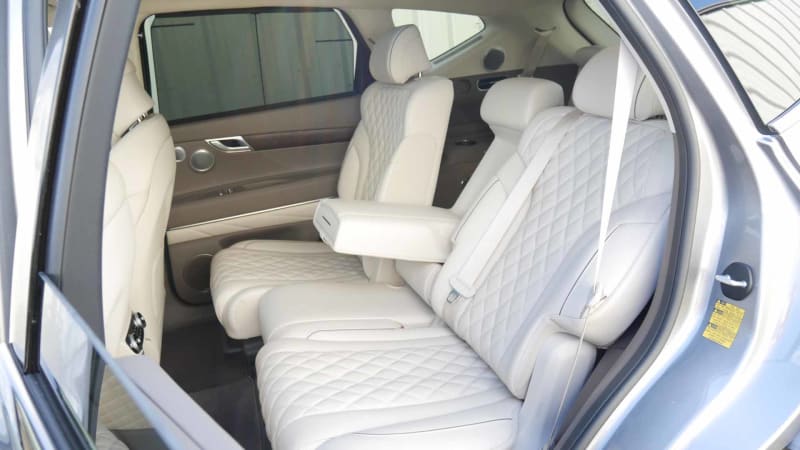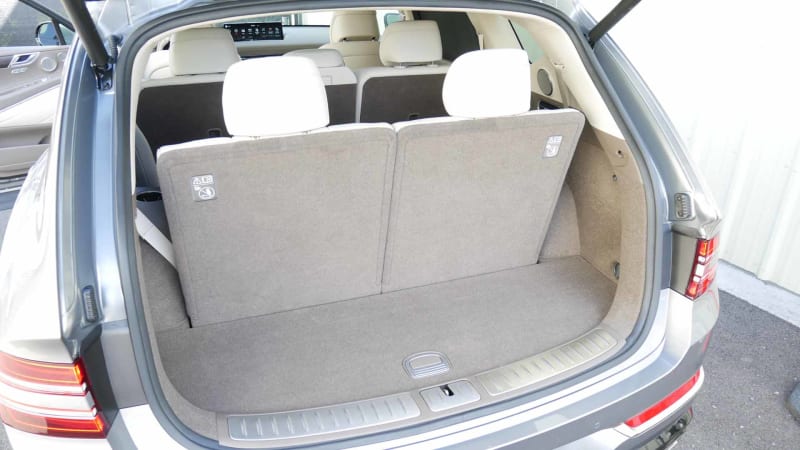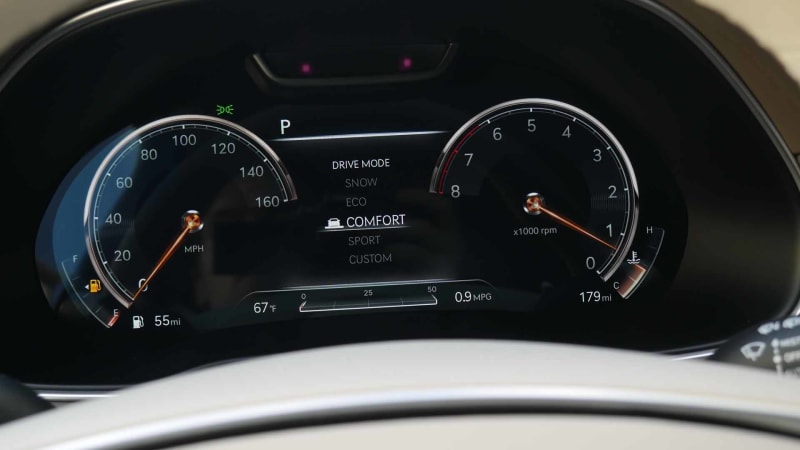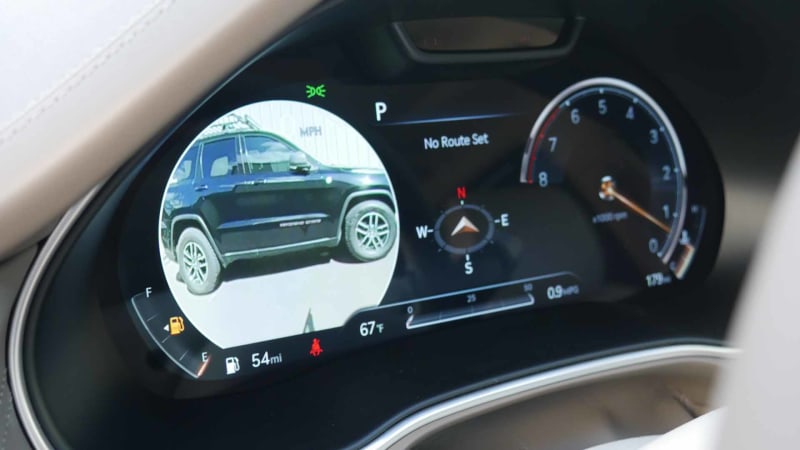If Genesis had it to do over again, it’s safe to say that its first three models would not have been a trio of sedans. The Genesis G80, G90, and G70 certainly have their merits, but when so many luxury-car intenders are shopping SUVs exclusively, the complete absence of such a vehicle in the lineup has prevented the brand from even getting consideration from a huge swath of the marketplace. Now, at last, comes salvation in the form of the GV80, the brand’s first SUV.
The arrival of the 2021 Genesis GV80 is such a momentous event that everything leading up to it feels like a preamble. This is the vehicle that will redefine Genesis, and that starts with its look. One upside of the GV80’s late arrival is that it skipped the milquetoast styling phase that the other models went through. The massive shield grille with the chain-link texture; the twin-slit motif seen in the headlights, the side repeaters, and the taillights; and the gently arching shoulder line all will be seen in other models — and are already in the newly redesigned G80 and the upcoming second-generation G70.
The GV80’s design makes it appear much lower and longer than the competing BMW X5 though the Bavarian is just an inch taller. The Genesis also will face off against the Mercedes-Benz GLE-Class, the Lincoln Aviator, and the Acura MDX, among many others. Like the BMW, Benz, and Lincoln, the Genesis features a north-south engine orientation and uses an RWD-based layout, a fact telegraphed by the long hood and the cab-rearward design.
Two engines are on offer: a turbocharged 2.5-liter inline-four and a turbocharged 3.5-liter V6. The four-cylinder turbo boasts output more often seen with V6 engines: 310 horsepower and 311 pound-feet of torque (both figures shade the GLE 350’s 2.0-liter turbo-four). The boosted V6 is good for 375 hp and 391 lb-ft, beating the six-cylinder X5 (335 hp, 330 lb-ft) but not the Aviator (400 hp, 415 lb-ft). Both engines work with an eight-speed automatic. Missing from the lineup are the sort of high-performance or hybrid powertrain choices offered by most of the aforementioned competitors.
Genesis serves up the GV80 a total of 10 different ways, and there are no factory options. The 2.5T can be had in Standard, Advanced, and Prestige trims, each with RWD or AWD. The AWD-only 3.5T offers the same three trims — each with a bit more content than their 2.5T equivalents — as well as a fourth 3.5T variant, the Advanced+, which is the only GV80 with a third-row seat.
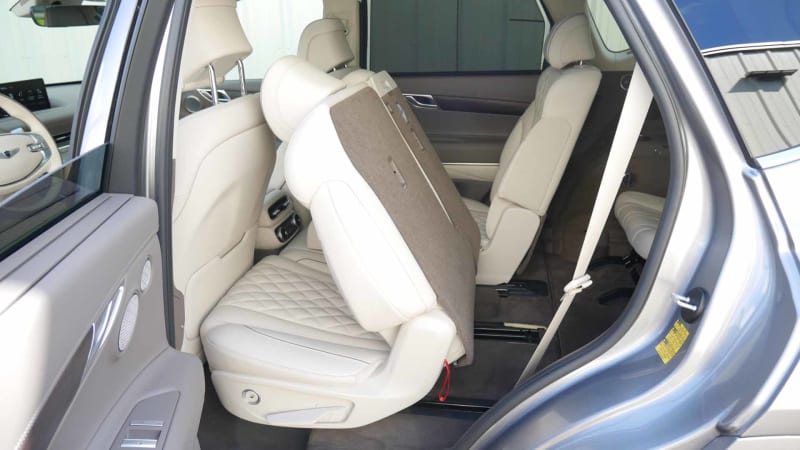
The limited availability of the third-row seat could be a hindrance in the marketplace, but when you attempt to climb into the third row, it’s clear that three-row packaging was not a priority. Push a button, and the second-row seat scoots forward, but the gap between seats and the wheel arch is tiny, making it difficult to squeeze through. The third-row cushion is also low to the floor and yet headroom is at a premium. And as we discovered in our first, non-driving review of the GV80, luggage space behind the third seat is extremely limited. The best that can be said is that power folding is included.
The accommodations in the second row are a much different story. There, a 6-footer can easily sit behind a similar-sized driver, with plenty of head- and legroom. And check the amenities: side window shades (on all but 2.5T RWD Standard), seat heating (2.5T Prestige, 3.5T Advanced and Prestige), and in the 3.5T Prestige, seat cooling, power side window shades, power folding, and eight-way power seat adjustment.
Up front, the driver looks out over a long hood, and that combined with a relatively low overall vehicle height makes for a pleasant, almost passenger-car feel. A power steering column is standard, though a greater range of fore-aft adjustment would be welcome. All Prestige models and the 3.5T Advanced come with adjustable side bolsters and seat cushion extenders as well as a massaging Active Bolster Seat.
The top-spec 3.5T Prestige model has a digital instrument cluster with a 3D effect, but its appearance is less dramatic than it sounds. With the digital cluster, the Blind Spot View Monitor, which shows a camera feed looking rearward down the side of the car when the turn signal is activated, briefly replaces the digital speedometer (left side) or tachometer (right side). This is one of the GV80’s few elements obviously shared with a Hyundai, but it’s an awesomely helpful one, and in fact an enhancement of the system we named our 2019 Autoblog Technology of the Year. Lesser models with the Blind Spot View Monitor show the feed (either left or right) in the tachometer, which like the information center between the gauges is digitally rendered.
The GV80’s showpiece interior tech feature, though, is the 14.5-inch touchscreen that’s standard on all models. The screen has an unusual long, shallow shape, and can show a single element or two elements with the second to the extreme right. Graphics are up-to-the-minute modern, and the sharpness of the feeds from the available multi-view camera is excellent. Naturally, Apple CarPlay and Android Auto are supported, though not in their wireless forms.
The shape and location of the screen put it close to the line of sight, but the far end is a reach for the driver. That issue is remedied by the presence of a console-mounted click-wheel although its design is less user-friendly than BMW’s iDrive controller. The wheel is flush mounted and has a concave shape, not unlike an old-school iPod. It provides some separation of feel from the dial shifter just aft of it and the smaller drive-mode dial just to the right, but turning the inset click-wheel is awkward. Similarly, jogging the click-wheel up, down, forward, or back is harder to do than with a surface-mounted version. It also has a touch-sensitive center section that responds to swipe or pinch motions.
Outside of the click-wheel, there are standard knobs for the temperature settings, with touch-sensitive buttons for the remainder of the climate controls. There are thumbwheels for volume and tuning, and while it’s great to have non-touchscreen controls for those functions, traditional knobs would be preferable.
The vibe Genesis is going for here is serene minimalism and, aesthetically, it certainly works. The dash is largely bereft of switchgear, with the major elements instead being the wide touchscreen and the dash vents that are presented as a single unit spanning the space. The center stack is integrated into the console, which has a floating appearance. Even the odd-looking steering wheel groups its buttons into the silver-finished areas, similar to the arrangement on the console. Nearly all surfaces are soft-touch with padded surfaces on the console’s sides and on the lower door panels, although leather is not included until you reach the mid-grade trims. And the two-tone color treatments add interest, particularly the striking green-and-brown combination.
Aiding the cause of serenity is the “Sounds of Nature” function, borrowed from Hyundai, which plays various tranquil noises over the audio system while an accompanying image appears on the vast display. And so it was that we set out from Manhattan listening to the sounds of a crackling fire. We might have picked Rainy Day, but since it already was raining, that seemed superfluous.
We started off in the 3.5T in full-boat Prestige trim. All 3.5T trims come with adaptive dampers that can adjust their firmness based on information from a forward-looking camera. On the cobblestone streets of the Meatpacking District and the patches of broken pavement on the West Side Highway, the GV80 displayed good bump isolation, slightly better than the standard-suspension version we would drive later. Both variants seem firmly sprung, with tight control of body motions, although the 3.5T is still able to deliver a plush ride — the standard-sprung version, slightly less so. The vehicles’ structure felt solid, devoid of creaks and squeaks even in these early production examples.
The GV80’s precise steering engendered confidence, most notably on the narrow lanes of the winding Saw Mill River Parkway, where the metal guardrail is only inches from the edge lines. The steering is pleasantly weighted, neither over-boosted nor unnecessarily heavy, though it lacks a strong sense of on-center. Overall, this is a highly agreeable chassis setup, and one without a dizzying array of configurability. The various drive modes don’t have a huge impact on the proceedings beyond the Sport mode’s aggressive throttle tip-in and its preference for lower gear ratios.
The turbo V6 is punchy, and throttle response is well-metered. Acceleration is strong but the GV80 doesn’t feel overly powerful. Genesis says that among those who’ve registered interest so far, the 3.5T is proving the more popular choice. For its part, the 2.5-liter makes impressive power for a turbo-four, and it’s certainly up to the job, although it demands a bit more patience accelerating up to freeway speeds or executing a two-lane pass. The biggest downside to the turbo-four is an engine note that’s gravelly under full-throttle acceleration. With either engine, fuel economy is just average for the segment. EPA estimates for the 2.5T are 21 mpg city and 25 mpg highway (RWD or AWD), which is on par with the GLE 350. For the 3.5T, the figures are 18/23 mpg, a few ticks behind the X5 xDrive40i.


